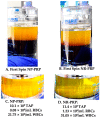Modifying Orthobiological PRP Therapies Are Imperative for the Advancement of Treatment Outcomes in Musculoskeletal Pathologies
- PMID: 36428501
- PMCID: PMC9687216
- DOI: 10.3390/biomedicines10112933
Modifying Orthobiological PRP Therapies Are Imperative for the Advancement of Treatment Outcomes in Musculoskeletal Pathologies
Abstract
Autologous biological cellular preparations have materialized as a growing area of medical advancement in interventional (orthopedic) practices and surgical interventions to provide an optimal tissue healing environment, particularly in tissues where standard healing is disrupted and repair and ultimately restoration of function is at risk. These cellular therapies are often referred to as orthobiologics and are derived from patient's own tissues to prepare point of care platelet-rich plasma (PRP), bone marrow concentrate (BMC), and adipose tissue concentrate (ATC). Orthobiological preparations are biological materials comprised of a wide variety of cell populations, cytokines, growth factors, molecules, and signaling cells. They can modulate and influence many other resident cells after they have been administered in specific diseased microenvironments. Jointly, the various orthobiological cell preparations are proficient to counteract persistent inflammation, respond to catabolic reactions, and reinstate tissue homeostasis. Ultimately, precisely delivered orthobiologics with a proper dose and bioformulation will contribute to tissue repair. Progress has been made in understanding orthobiological technologies where the safety and relatively easy manipulation of orthobiological treatment tools has been demonstrated in clinical applications. Although more positive than negative patient outcome results have been registered in the literature, definitive and accepted standards to prepare specific cellular orthobiologics are still lacking. To promote significant and consistent clinical outcomes, we will present a review of methods for implementing dosing strategies, using bioformulations tailored to the pathoanatomic process of the tissue, and adopting variable preparation and injection volume policies. By optimizing the dose and specificity of orthobiologics, local cellular synergistic behavior will increase, potentially leading to better pain killing effects, effective immunomodulation, control of inflammation, and (neo) angiogenesis, ultimately contributing to functionally restored body movement patterns.
Keywords: angiogenesis; autologous orthobiologics; bioformulations; dosing; evolutionary medicine; immunomodulation; painkilling effects; platelet-rich plasma; platelets; platelet–leukocyte interactions.
Conflict of interest statement
Peter A. Everts is also Chief Scientific Officer for EmCyte Corporation.
Figures





Similar articles
-
Basic Science of Autologous Orthobiologics: Part 1. Platelet-Rich Plasma.Phys Med Rehabil Clin N Am. 2023 Feb;34(1):1-23. doi: 10.1016/j.pmr.2022.08.003. Epub 2022 Oct 17. Phys Med Rehabil Clin N Am. 2023. PMID: 36410877 Review.
-
Angiogenesis and Tissue Repair Depend on Platelet Dosing and Bioformulation Strategies Following Orthobiological Platelet-Rich Plasma Procedures: A Narrative Review.Biomedicines. 2023 Jul 6;11(7):1922. doi: 10.3390/biomedicines11071922. Biomedicines. 2023. PMID: 37509560 Free PMC article. Review.
-
Basic Science of Autologous Orthobiologics: Part 2. Mesenchymal Stem Cells.Phys Med Rehabil Clin N Am. 2023 Feb;34(1):25-47. doi: 10.1016/j.pmr.2022.08.004. Epub 2022 Oct 18. Phys Med Rehabil Clin N Am. 2023. PMID: 36410885 Review.
-
Application of Orthobiologics in Achilles Tendinopathy: A Review.Life (Basel). 2022 Mar 9;12(3):399. doi: 10.3390/life12030399. Life (Basel). 2022. PMID: 35330150 Free PMC article. Review.
-
Platelet Rich Plasma in Orthopedic Surgical Medicine.Platelets. 2021 Feb 17;32(2):163-174. doi: 10.1080/09537104.2020.1869717. Epub 2021 Jan 5. Platelets. 2021. PMID: 33400591 Review.
Cited by
-
Influence of Platelet Concentration on the Clinical Outcome of Platelet-Rich Plasma Injections in Knee Osteoarthritis.Am J Sports Med. 2024 Nov;52(13):3223-3231. doi: 10.1177/03635465241283463. Epub 2024 Oct 14. Am J Sports Med. 2024. PMID: 39397728 Free PMC article.
-
Advancements in Regenerative Therapies for Orthopedics: A Comprehensive Review of Platelet-Rich Plasma, Mesenchymal Stem Cells, Peptide Therapies, and Biomimetic Applications.J Clin Med. 2025 Mar 18;14(6):2061. doi: 10.3390/jcm14062061. J Clin Med. 2025. PMID: 40142869 Free PMC article. Review.
-
Current Challenges in the Development of Platelet-Rich Plasma-Based Therapies.Biomed Res Int. 2024 Aug 9;2024:6444120. doi: 10.1155/2024/6444120. eCollection 2024. Biomed Res Int. 2024. PMID: 39157212 Free PMC article. Review.
-
High-Dose Neutrophil-Depleted Platelet-Rich Plasma Therapy for Knee Osteoarthritis: A Retrospective Study.J Clin Med. 2024 Aug 15;13(16):4816. doi: 10.3390/jcm13164816. J Clin Med. 2024. PMID: 39200958 Free PMC article.
-
Re-Evaluating Platelet-Rich Plasma Dosing Strategies in Sports Medicine: The Role of the "10 Billion Platelet Dose" in Optimizing Therapeutic Outcomes-A Narrative Review.J Clin Med. 2025 Apr 15;14(8):2714. doi: 10.3390/jcm14082714. J Clin Med. 2025. PMID: 40283544 Free PMC article. Review.
References
-
- Everts P.A., Flanagan G., Podesta L. Autologous Orthobiologics. In: Mostoufi S.A., George T.K., Tria A.J. Jr., editors. Clinical Guide to Musculoskeletal Medicine: A Multidisciplinary Approach. Springer International Publishing; Cham, Switzerland: 2022. pp. 651–679.
-
- Magalon J., Brandin T., Francois P., Degioanni C., De Maria L., Grimaud F., Veran J., Dignat-George F., Sabatier F. Technical and Biological Review of Authorized Medical Devices for Platelets-Rich Plasma Preparation in the Field of Regenerative Medicine. Platelets. 2021;32:200–208. doi: 10.1080/09537104.2020.1832653. - DOI - PubMed
-
- Korpershoek J.V., Vonk L.A., De Windt T.S., Admiraal J., Kester E.C., Van Egmond N., Saris D.B.F., Custers R.J.H. Intra-Articular Injection with Autologous Conditioned Plasma Does Not Lead to a Clinically Relevant Improvement of Knee Osteoarthritis: A Prospective Case Series of 140 Patients with 1-Year Follow-Up. Acta Orthop. 2020;91:743–749. doi: 10.1080/17453674.2020.1795366. - DOI - PMC - PubMed
Publication types
LinkOut - more resources
Full Text Sources
Research Materials

